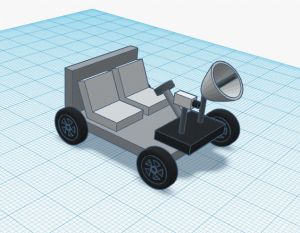Moon Camp Explorers Gallery 2020-2021
In Moon Camp Explorers each team’s mission is to 3D design a complete Moon Camp using Tinkercad. They also have to explain how they will use local resources, protect astronauts from the dangerous of space and describe the living and working facilities.
Team: LR6V
Liepajas Raina Secondary School N.6 Liepaja Latvia 14, 13
External link for 3d
|
Project description
It is planned to build 4-module compartments of the lunar base to provide 2 astronauts with a living base on the Moon’s South Pole region near the crater. The Sun in the Moon’s South Pole region shines around the clock to get energy from the solar panels and the nuclear reactor. The lunar base modules are large enough to fit: |
|||
|
Where do you want to build your Moon Camp?
Close to the Lunar Poles Why did you choose this location?
We have chosen the plato next to Amudsen Crater. Amundsen is a large lunar impact crater located near the south pole of the Moon (Coordinates: 84.5°S 82.8°E). How do you plan to build your Moon Camp? Which materials would you use?
We will use volcanic powder to make bricks. The regolith is held together using a process called sintering, where concentrated sunlight or lasers bond the material together. We will use 3D printers to construct specially shaped bricks. Explain how your Moon Camp will provide the astronauts with:
|
|||
|
Water
|
Food
|
Electricity
|
Air
|
|
The Moon holds sizable reserves of water, secreted as ice in the deep cold of permanently shadowed craters near the poles as well in regolith as small ice grains. We will use Aqua Factorem which is ultra-low-energy lunar water extraction method. Ice grains, which make up about 5% of the regolith, will be cleaned on site and then transported to a processing unit in solid phase and converted into water. |
We will get food by a technique hydroponic. It’s a technique where you can grow plants without using soil. The plants will be grown by using nutrients in water. |
We get electricity through solar cells and nuclear reactor. The moon is exposed to sunlight constantly, except briefly during a rare lunar eclipse. That makes the solar cells really useful. A small nuclear reactor will generate heat that is transferred to the power conversion system. The power conversion system will consist of engines that are designed to operate on reactor heat rather than combustible fuel. Those engines use the heat, convert it to electric power that is conditioned and distributed to user equipment. Each of four Lunar Nuclear Reactor will be generating 2.3 kilowatts of power. |
The other part of ice grains will be used in a chemical processing unit where electrolysis of water produces hydrogen for rocket propellant and oxygen. |
|
Describe a day on the Moon for one of your Moon Camp astronauts
Astronauts get up at 6 in the morning, do their physical activities, personal hygiene and have breakfast. Then comes technical inspection of all automatic systems – mining ice grains, power station, oxygen producing unit and work in a laboratory and a food farm. Lunch at 12.00. Then astronauts put on their spacesuits and go for outdoor work through sluice. they have to inspect on site power station, solar panels, oxygen electrolysis unit and operation of transportation platform and driller. Then they take the moon rover to go to explore the nearest Amundsen crater. When they come back to the base, they leave their space suits in special camera and continue work in the office and laboratory. At 18.00 they have dinner, but after that communication with the Earth ESA Center. Then it is time for night rest. |
|||






